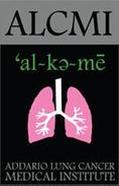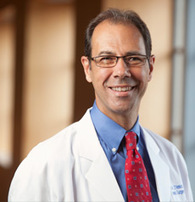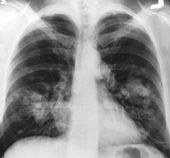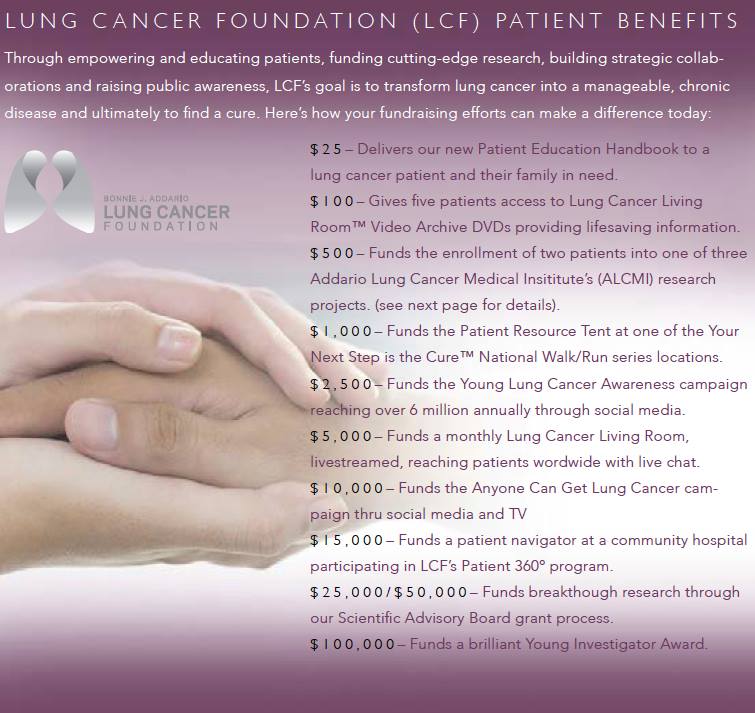|
This article was originally published at 4:24 pm on Tuesday, December 3, 2013 by Kathryn Roethel of the San Francisco Chronicle When it comes to U.S. cancer research funding, deadly disease doesn't always translate into dollars. Lung cancer - the nation's top cancer killer - ranks near the bottom by many measures of funding. Lung cancer's five-year survival rates have hovered around 15 percent for the past four decades, while survival rates for most other cancers have climbed. Ninety-nine percent of prostate cancer patients and 89 percent of breast cancer patients now live at least five years past diagnosis. Lung cancer symptoms are vague and there isn't a screening approved for the general population, so doctors often discover lung cancer in advanced stages. Last year, the National Cancer Institute, a division of the government's National Institutes of Health, awarded breast cancer researchers nearly twice as much funding as lung cancer scientists. In the ratio of research dollars to deaths for the 10 most common types of cancer, lung cancer ranks near the bottom of the list. One problem, according to Dr. Heather Wakelee, a thoracic oncologist at the Stanford Cancer Institute, is that most people view lung cancer as a smoker's disease that could have been prevented. While a majority of U.S. lung cancer patients are current or former smokers, about 20 percent of women and 10 percent of men with lung cancer never smoked. If only nonsmokers' deaths were counted, lung cancer would still rank in the top 10 deadliest types of the disease. The promising news, Wakelee said, is tumors often mutate differently in nonsmokers, and new drugs are being developed to target those mutations and increase survival rates. Here's a look at lung cancer funding, by the numbers. 159,480 The number of Americans projected to die of lung cancer in 2013. Lung cancer kills about four times more people than breast cancer and three times more than colorectal cancer, the second leading cancer killer. $314.6 million The amount of research dollars lung cancer received from the National Cancer Institute in 2012, making it second to breast cancer in federal funding. Breast cancer researchers received nearly twice as much. $2,000 When the amount of NCI lung cancer research funding is divided by the number lung cancer deaths, it equates to about $2,000 for each person who died last year. For breast cancer, it's more than $15,000 per death. It's about $9,000 for each prostate cancer death, and $5,000 for each colon cancer death. 15% The percentage of Americans with lung cancer who have never smoked, according to the Lung Cancer Foundation of America. Forty-five percent are former smokers, and the remaining 40 percent currently smoke.
0 Comments
11/6/2013 The Bonnie J. Addario Lung Cancer Foundation presents: "The Next Decade in Lung Cancer"Read Now The brightest minds in research, academics and advocacy unite at the Lung Cancer Living Room. Published on November 5, 2013 by The Bonnie J. Addario Lung Cancer Foundation SAN CARLOS, CA, Nov. 5, 2013 /PRNewswire-USNewswire/ -- The Bonnie J. Addario Lung Cancer Foundation (ALCF) is proud to present The Next Decade in Lung Cancer, a three-part series of the Lung Cancer Living Room, the nation's premiere live-streamed support group for patients, family and friends. "We are asking the big question. What will it take to make lung cancer a chronically managed disease in the next 10 years?" said Bonnie J. Addario, lung cancer survivor and founder of the ALCF. "The Next Decade in Lung Cancer offers a glimpse into the future from the perspective of researchers, advocates and most importantly patients." The three-part series will unite industry leaders in medicine, research and technology who will discuss the latest advancements and breakthroughs in lung cancer. Advocacy and policy agencies and foundations will also discuss access, information, education and needed legislative changes. The series, which will take place over the next three months, kicks off on November 10, 2013 at 2 p.m. (PST). Guests who attend the Living Room in-person will have the opportunity to network with other patients and with the guest speakers listed below. Online guests can also participate through the live stream, asking questions and sending comments via a live chat function. The session also airs at a later date locally on Peninsula TV. Guest Speakers:
The ALCF regularly hosts the Living Room on the third Tuesday of every month and the program is live-streamed online. It is the nation's premier lung cancer support group for lung cancer patients and their families, offering expert opinion and advice not found anywhere else. Visit www.ustream.com and select the Lung Cancer Living Room Support Group channel to see the video archive, including full length videos and 20-minute condensed highlighted versions, available the week after the group meets. The patient empowerment educational series is made possible through funding partners: Biodesix, Bristol-Myers Squibb, Celgene, Genentech and The Safeway Foundation. About The Bonnie J. Addario Lung Cancer Foundation The Bonnie J. Addario Lung Cancer Foundation (ALCF) is one of the largest philanthropies (patient-founded, patient-focused, and patient-driven) devoted exclusively to eradicating Lung Cancer through research, early detection, education, and treatment. The Foundation works with a diverse group of physicians, organizations, industry partners, individuals, survivors, and their families to identify solutions and make timely and meaningful change. The ALCF was established on March 1, 2006 as a 501c(3) non-profit organization and has raised more than $10 million for lung cancer research and patient services. Read more here.  INHERIT EGFR Study Expands to Second Site SAN CARLOS, Calif., Oct. 30, 2013 /PRNewswire-USNewswire/ -- A new research study, funded by the Bonnie J. Addario Lung Cancer Foundation (ALCF), is aiming to understand how an inherited gene in some lung cancer patients could serve as an early detection screening for family members. "We're hoping this study provides new insight for methods to screen for lung cancer in people who might not have otherwise qualified for screening: the family members of lung cancer patients," said Bonnie J. Addario, lung cancer survivor and founder of the ALCF. "And we also hope to show that lung cancer doesn't just affect people who smoke." The INHERIT (Investigating Hereditary Risk from T790M) research study, facilitated by the Addario Lung Cancer Medical Institute (ALCMI), is the first to apply inherited familial genetics – widely used to assess risk for breast and colon cancer – to provide insight into lung cancer. Dr. Geoffrey Oxnard and a team of physicians at Dana-Farber/Brigham and Women's Cancer Center in Boston, MA are leading the INHERIT study to understand whether the presence of the T790M gene mutation in lung cancers is associated with an inherited gene alteration. Oxnard's team will also examine whether having the inherited form of T790M raises the risk of lung cancer in patients and families. The ALCMI study was launched at Dana-Farber and has now expanded to include Vanderbilt-Ingram Cancer Center in Nashville, Tenn. No travel is required to participate. "This is the first time we are using cancer genetics to offer insight into inherited familial genetics. For breast cancer or colon cancer, it is patients with a family history that get evaluated for inherited mutations in cancer risk genes," said Geoffrey Oxnard, MD, the lead researcher on the study. "For lung cancer, we propose that it is patients with specific genetic subtypes of lung cancer, those carrying the EGFR T790M mutation, that need to be evaluated for an inherited mutation in their family." Ultimately, the study aims to identify individuals and families who may have an increased risk of developing lung cancer so they can work with their physicians to reduce and manage that risk. Understanding lung cancer's underlying biology in high-risk families could also provide unique insight into why the disease develops and determine whether "germline" (inherited) factors may partly explain lung cancer in individuals without apparent carcinogenic association. "We are funding this study because of our patient first commitment," Addario said, "and with the hope to raise awareness that the risk for lung cancer exists regardless of smoking history. In 2013 alone, 34,000 people who never smoked will be diagnosed with lung cancer. That population of cancer patients, isolated, would represent the seventh leading cancer in the U.S." The INHERIT study is offered through Dana-Farber/Harvard Cancer Center, Vanderbilt-Ingram Cancer Center, and soon at other ALCMI member institutions in the United States and Europe. It is led by Geoffrey Oxnard, MD at Dana-Farber/Brigham and Women's Cancer Center. Dana-Farber and Vanderbilt are National Cancer Institute-designated Comprehensive Cancer Centers. This study is also funded by the Conquer Cancer Foundation of the American Society of Clinical Oncology (ASCO). FOR MORE INFORMATION: View video on T790 mutation research at www.dana-farber.org/T790Mstudy Contact Dr. Oxnard at 617-632-6049, dfcifamilialT790M@dfci.harvard.edu About the Bonnie J. Addario Lung Cancer Foundation The Bonnie J. Addario Lung Cancer Foundation (ALCF) is one of the largest philanthropies (patient-founded, patient-focused, and patient-driven) devoted exclusively to eradicating Lung Cancer through research, early detection, education, and treatment. The Foundation works with a diverse group of physicians, organizations, industry partners, individuals, survivors, and their families to identify solutions and make timely and meaningful change. The ALCF was established on March 1, 2006 as a 501c(3) non-profit organization and has raised more than $10 million for lung cancer research and patient services. About the Addario Lung Cancer Medical Institute The Addario Lung Cancer Medical Institute (ALCMI) is a patient-founded, patient-focused 501c(3) non-profit research consortium established in 2008 that directly facilitates basic and clinical research to accelerate the discovery and delivery of advancements to patients. By bringing together a world-class team of scientists and clinicians from over 20 academic and community medical centers in the U.S. and Europe, ALCMI has rapidly established a critical mass of expertise and dedicated research infrastructures linked together through centrally coordinated research. SOURCE Bonnie J. Addario Lung Cancer Foundation Read more: http://www.digitaljournal.com/pr/1556776#ixzz2jK46ND7q The following was originally published at DukeHealth.org by Dr. Thomas A. D’Amico on June 21st, 2011. Thomas A. D’Amico, MD, is a professor of surgery and director of the Duke Cancer Institute’s lung cancer program. He was elected chair of the National Comprehensive Cancer Network board of directors in 2010. Lung Cancer: Is “The Blame Game” Hurting our Progress?  Thomas A. D'Amico, MD Thomas A. D'Amico, MD As a thoracic surgeon, I operate on lung cancer patients every day. We discuss life-and-death issues regarding their surgeries, but we don’t usually talk about how they feel about their disease. At a recent lung cancer advocacy event, I had the opportunity to hear one of my patients tell her story. A former Division I soccer player for East Carolina University, 24-year-old Taylor Bell was diagnosed with lung cancer two weeks after her 21st birthday. She puts a very different face on lung cancer than most people expect. She’s very grateful for her survival, but she says that, even when she’s talking to survivors of other types of cancer -- to anyone, really -- when she tells people she has had lung cancer, inevitably everyone asks the same thing: “Did you smoke?” Her point of view is, “Why is that the most important thing you want to know about me?” It’s offensive to her because, number one, she didn’t smoke, and number two, what if she did? Would that mean that she deserved the disease? Assigning Blame for Lung Cancer That is the underlying assumption when many people think about lung cancer: In an international survey commissioned in 2010 by the Global Lung Cancer Coalition, 22 percent of U.S. respondents admitted they feel less sympathy for lung cancer patients than for patients with other types of cancer, because of the link to smoking. The reality is that 15 to 20 percent of folks who get lung cancer have no personal firsthand experience with tobacco. Some, like Taylor Bell, are complete non-smokers. Some have been exposed to secondhand smoke, which certainly is not their fault. If you counted just deaths from lung cancer among nonsmokers, lung cancer would still be the sixth leading cause of cancer-related deaths in the United States. But no one should be blamed for getting cancer, regardless of their smoking history. Most smokers first start the habit as teenagers, and by adulthood it becomes entrenched; nicotine addiction is among the hardest to overcome. The real issue is not the smoker who develops cancer; it’s how we as a society assign blame for disease. If we are to measure our sympathies for the ill by the behaviors that may have contributed to their illness, what about the patients with debilitating heart disease who have led high-stress, low-exercise lifestyles, or people with type 2 diabetes who had poor eating habits? What about the smokers who didn’t develop lung cancer but developed breast cancer, heart disease, or stroke? Would you have more sympathy for a smoker with lung cancer if you knew he had grown up with little education about the dangers of smoking? What about if the individual had a strong genetic predisposition to nicotine addiction? Stigma Slows Progress in Fight Against Lung Cancer The truth is, it’s rare that we can draw a straight line from a person’s disease to their lifestyle choices, and applying moral judgments to the ill is not only a waste of energy, but also a slippery moral slope. I believe the public-health campaign against smoking and tobacco use has had unintended consequences: not only stigma for the victims of diseases associated with smoking, but actually slowing our progress in the fight against those diseases. And that is something we need to pay attention to. The fact is that lung cancer is the most important cancer disease in our country, and indeed among all developed countries, in terms of its impact. In 2010, lung cancer caused 157,300 deaths in the United States, more than breast, prostate, and colon cancer combined, according to estimates from the American Cancer Society. In 2006, the most recent year for which we have estimates, we spent $10.3 billion in care for lung cancer patients, and the estimated loss of economic productivity due to lung cancer is $36.1 billion -- far higher than the next-highest figure (which is breast cancer, at a $12.1-billion loss). The burden of this disease to us as a society should be, in itself, enough to compel us to do everything we can to improve diagnosis and treatment. Yet lung cancer receives much less research funding than other types of cancer that cause fewer deaths. The stigma associated with lung cancer definitely takes its toll on survivors personally, and it’s possible that it also affects research funding for the disease. Using the most recent available data on National Cancer Institute research funding, lung cancer received only $1,875 per death, compared to $17,028 per breast cancer death, $10,638 per prostate cancer death, and $6,008 per colorectal cancer death. It’s impossible to read the minds of people who make decisions regarding funding for lung cancer research, but I think funding disparities can be attributed partly to a combination of the smoking stigma and ageism. If a 73-year-old person has a life-threatening disease, that’s not perceived as being as important to society as a disease that affects younger people. And an older patient population also means less patient advocacy. The fight against breast cancer, for example, has been promoted successfully because many young women who are survivors have their life to give to raising awareness. The cure rate for lung cancer is much lower than for breast cancer. So there are fewer advocates. Need for New Screening Methods and Biologic Therapies There is a need for greater research funding to advance two priorities that could make a significant difference for patients with lung cancer -- perfection of screening methods to catch more cases in the early stages, and stepped-up evaluation of biologic therapies, which can be equally as effective or more effective than chemotherapy without the overall toxicity. Improved screening is an urgent need. Today, only about 20 percent of lung-cancer cases are caught at stage one. If we could increase that to 40 percent, we would improve survival dramatically. Spiral computed tomography (CT) scan screening is a promising technique that’s being tested for patients known to be at high risk, but as a widespread tool, even CT has a drawback: the high chance of false positives. Your CT scan might show a little nodule, but that does not necessarily mean you have lung cancer, and follow-up testing for lung cancer is invasive: if you have a positive screening for a mammography, you get a needle biopsy, but a positive screen from a CT scan might lead to a surgery. We would like to be able to determine your true cancer status without having to do additional CT screens on you for the next five years or subjecting you to an unnecessary lung biopsy. A line of research that holds much promise is perfecting a method for combining CT scans with a serum or urine test that detects a protein or other biomarker. Even if we improve diagnosis, we’ll always have people who present with advanced disease, and the cure rate for those people is, frankly, dismal. One way to improve that rate is with better targeting of biologic therapies. Industry is producing these agents faster than we can test them. We need to put more effort into testing and enhancing these agents -- which could improve treatment for others cancers as well. For instance, Avastin (bevacizumab) is now known to be successful against lung cancer, but it wasn’t originally conceived as a lung cancer agent. To carry out these research priorities, we must erase the stigma that accompanies lung cancer and give the disease the full research support that its sufferers and their families deserve. In the meantime, we will count on survivors such as Taylor Bell, who handles the smoking question with grace. After she tells people that no, she never smoked, the second question usually is: “Well, how did you get it?” Her response: “Why does anyone get cancer?” 6/26/2013 More #Research Needs to Be Done On Treatment For #LungCancer Among Non-Smoking #WomenRead NowThis story originally published by Sam Goodwin on HGNG.com on 6/26/13.  The International Association for the Study of Lung Cancer (IASLC) finds that much more research needs to be done on treatment given to non-smoking women for lung cancer. An estimated 516,000 women worldwide are affected by lung cancer and 100,000 of these women are from the United States. Up until now, women with lung cancer have been given the same treatment as men. However, numerous studies have highlighted different characteristics of lung cancer in women. Hence, there is a need for more research to be done on lung cancer treatment given to women, especially those who don't smoke, states the International Association for the Study of Lung Cancer (IASLC). Researchers from the University of Toulouse III in France looked into the clinical, pathological and biological characteristics of lung cancer in 140 women. They found that 63 participants had never smoked in their lives while 77 were either former or current smokers. Researchers compared the findings of both groups and found differential genetic alteration repartition in women according to their tobacco status. Around 50.8 percent of women who had never smoked displayed an EGFR mutation while only 10.4 percent of current/former smokers showed the same mutation. However, 33.8% of current/former smokers showed K-Ras mutation while only 9.5 percent of women who had never smoked showed this form of mutation. The researchers also observed a higher percentage of estrogen receptors (ER) α expression in patients who never smoked when compared with smokers. This led researchers to conclude that lung cancer in women who have never smoked is more frequently associated with EGFR mutations and estrogen receptor (ER) over expression. "These findings underline the possibility of treatment for women who have never smoked with drugs to target hormonal factors, genetic abnormalities, or both," the authors say. The study is published in the July issue of the Journal of Thoracic Oncology.
If you answered “yes,you may be eligible to participate in a study by a researcher at Capella University – your experience matters! Participation in this study involves a one-time interview, either in- person, by webcam or, if necessary, by telephone. A $10 gift card or a $10 donation to any lung cancer organization will be provided as compensation for your time. Please contact: Rachael at RBrandt@capellauniversity.edu for more information.  Originally published at medpagetoday.com by Charles Bankhead, Staff Writer, MedPage Today on April 05, 2013. Reviewed by Robert Jasmer, MD; Associate Clinical Professor of Medicine, University of California, San Francisco and Dorothy Caputo, MA, BSN, RN, Nurse Planner  All patients with advanced lung adenocarcinoma should undergo testing forEGFR and ALK mutations to determine their eligibility for targeted therapies, according to a jointly developed guideline from three organizations. Patients should undergo EGFR testing at diagnosis of advanced disease or at recurrence or progression if they were not tested at earlier disease stages. ALKrearrangement testing is suggested by the International Association for the Study of Lung Cancer, the College of American Pathologists, and the Association for Molecular Pathology. Patients should not be excluded from testing because of smoking status or clinical characteristics, the guideline authors said in an article published online in the Journal of Thoracic Oncology. "It was recognized by each of these three organizations that there was a gap in knowledge, a gap in communication, and variance around the world in how this testing ought to be done," first author Neil I. Lindeman, MD, a pathologist at Brigham & Women's Hospital in Boston, said in video statement. "We decided collectively ... that these three voices should come together in order to make a consensus guideline." The consensus opinion of the guideline panel is that EGFR and ALK testing should be encouraged for patients with stage I, II, or III disease at diagnosis. EGFR testing should have priority over all other genes, followed by ALK. "Any oncologist should be able to provide this testing and should do this testing to give their patients optimal care," Gregory Riely, MD, a medical oncologist at Memorial Sloan-Kettering Cancer Center in New York city, said in the video. "With a proper biomarker, I can tell patients that they have a 70% to 80% chance of responding to a treatment rather than saying that they have a 1 in 10 chance of responding to treatment," he added. Other points made in the guideline include:
The guideline addresses a variety of other issues related to testing techniques and processes, quality control, testing for secondary mutations and for other genes, and reporting results. The broad recommendations for testing and the guideline's emphasis on urgency in obtaining test results reflect practices already in place at leading cancer centers, according to Edward Kim, MD, of Carolinas HealthCare System's Levine Cancer Institute in Charlotte, N.C. "Testing should be based on type of patient (i.e. histology) and not clinical characteristics (i.e. smoking status or ethnicity)," said Kim, who was not involved in writing the guideline. "Both tests (EGFR and ALK) are recommended to be ordered at diagnosis, which is our current practice at Levine Cancer Institute. "Although 'within 2 weeks' for results is recommended, I hope that the turnaround time can be shortened in the near future. Patients with lung cancer are anxious to begin therapy, and longer delays will preclude the use of these molecular agents in the front-line setting." The guideline authors disclosed relationships with Novartis, Millennium, Arqule/Daiichi Sankyo, NanoString, Genzyme, Infinity, Sequenom, Remedica Medical Education, Abbott, Existence Genetics, CymoGen Dx, Applied Spectral Imaging, Parteq-Queen's Commercialization Office, Merck, Eli Lilly, Pfizer, OSI/Genentech/Roche, AstraZeneca, Boehringer Ingelheim, Amgen, GlaxoSmithKline, Bristol-Myers Squibb, and sanofi-aventis. Several authors disclosed royalties related to publications and fees received as expert witnesses. Primary source: Journal of Thoracic Oncology
Source reference: Lindeman NI et al. "Molecular testing guideline for selection of lung cancer patients for EGFR and ALK tyrosine kinase inhibitors: Guideline from the College of American Pathologists, International Association for the Study of Lung Cancer, and Association for Molecular Pathology" J Thorac Oncol 2013; DOI: 10.1097/JTO.0bO13ee318290868f.  IBM’s Watson supercomputer has gone from game show king to doctor’s office helper. You may recall the epic man vs. machine battle two years ago in which the supercomputer beat former champions on the show Jeopardy. Well, now there’s a Watson tablet and computer app doctors can use to help treat lung cancer and another for health insurance companies to figure out which claims to pay, reports The Associated Press. For the cancer program, Watson analyzed 1,500 lung cancer cases from medical records, plus millions of pages of medical text. It also is able to learn when corrected for generating a wrong answer. Armed with all this data, Watson will suggest to doctors which treatments will most likely succeed, prioritized by its level of confidence in them. The Maine Center for Cancer Medicine and WestMed in New York's Westchester County will both be using the lung cancer app by March. Health insurer WellPoint, which actually will be selling both applications as part of an agreement with IBM, is already using the Watson app in Indiana, Kentucky, Ohio and Wisconsin to sift through insurance claims and determine which ones to authorize. Since Watson’s victory on Jeopardy, IBM says the supercomputer’s performance has increased by 240 percent and been used to analyze finance and health care data as well as in a university setting to research big data, analytics and cognitive computing. The company also is moving some of its underlying technologies from the supercomputer into new entry-level servers used by SMBs. IBM’s recently announced Power Express servers will integrate some hardware and software elements derived from Watson. Expect to hear more about Watson—IBM says its use “will be expanding to production-level deployments in new use cases and industries going forward.” Check out this two-minute video, in which doctors talk about how Watson will be used to determine treatments for lung cancer:  This article was originally published at About.com on January 10th, 2013 by Lynne Eldridge, MD. ------- Studies have shown that when it comes to breast cancer, older women are more likely to be diagnosed with advanced stages of the disease. Not so with lung cancer - at least in recent studies in Denmark and England. Instead, it seems the slogan reads "early age later stage." Researchers in Denmark set out to evaluate the stage of lung cancer at which different age groups are diagnosed. Looking at people aged 65-69, those aged 70 to 74 were 18% less likely to be diagnosed with late stage disease. The trend continued on: Those aged 75 to 79 were 26% less likely, 80 to 84 were 27% less likely, and those over 85, 34% less likely to have a diagnosis of late disease. Since the stage at diagnosis makes a tremendous difference in long-term survival from lung cancer, this is something to stand up and take note of. Why would younger people be less likely to diagnosed with lung cancer until it's reached the later stages of the disease? Or to ask the question in another way: Why does age seem to have a protective effect against late stage lung cancer diagnosis? Possibilities shared with me by Georogios Lyratzopoulous MD, one of the investigators in another study in England demonstating "early age later stage" include:
The conclusion based on these findings is that efforts to diagnose lung cancer early need to be tailored to different age groups. The stage of a lung cancer at the time of diagnosis can have a huge impact on younger patients with lung cancer. In the study above from Denmark, only 17% of the cancers were diagnosed at stage 1 and stage 2. To tailor the diagnostic process for different age groups, we need to focus on more diagnostic research instead of just treatment research. Sources:
|
Details
|




 RSS Feed
RSS Feed
